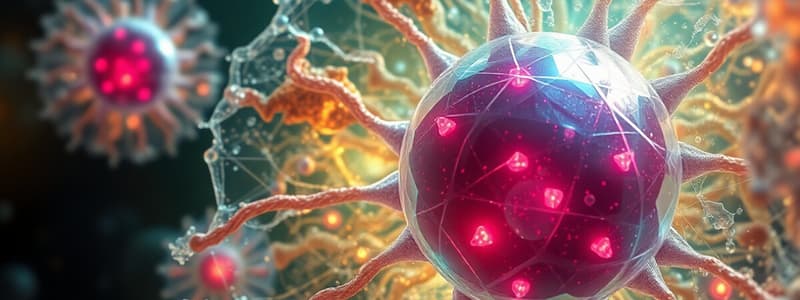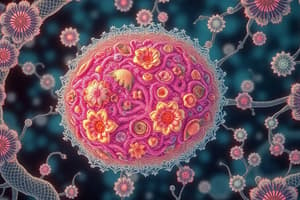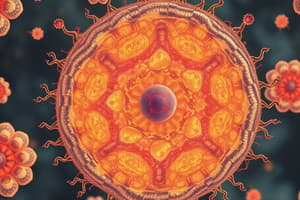Podcast
Questions and Answers
What is a defining feature of eukaryotic cells that distinguishes them from prokaryotic cells?
What is a defining feature of eukaryotic cells that distinguishes them from prokaryotic cells?
- Presence of a nucleus (correct)
- Smaller size compared to prokaryotic cells
- Lack of membrane-bound organelles
- Ability to reproduce asexually only
Which organelle is primarily responsible for ATP production in eukaryotic cells?
Which organelle is primarily responsible for ATP production in eukaryotic cells?
- Endoplasmic Reticulum
- Lysosomes
- Mitochondria (correct)
- Golgi Apparatus
Which structure is found in plant cells but not in animal cells?
Which structure is found in plant cells but not in animal cells?
- Cell membrane
- Mitochondria
- Centrioles
- Vacuoles (correct)
What is the function of the rough endoplasmic reticulum?
What is the function of the rough endoplasmic reticulum?
Which of the following statements regarding fungal cells is correct?
Which of the following statements regarding fungal cells is correct?
Which process of reproduction involves the formation of gametes in multicellular organisms?
Which process of reproduction involves the formation of gametes in multicellular organisms?
What is one significant evolutionary theory regarding the origin of eukaryotic cells?
What is one significant evolutionary theory regarding the origin of eukaryotic cells?
In what way are eukaryotic cells crucial to multicellular organisms?
In what way are eukaryotic cells crucial to multicellular organisms?
Flashcards are hidden until you start studying
Study Notes
Eukaryotic Cells
-
Definition: Eukaryotic cells are complex cells that contain a nucleus and other membrane-bound organelles.
-
Key Characteristics:
- Nucleus: Contains the cell’s genetic material (DNA).
- Organelles: Specialized structures with specific functions (e.g., mitochondria, endoplasmic reticulum).
- Size: Generally larger than prokaryotic cells (10-100 micrometers).
- Cell Membrane: Phospholipid bilayer providing structure and regulating transport.
-
Types of Eukaryotic Cells:
- Animal Cells: Lack cell walls, possess centrioles, and have small vacuoles.
- Plant Cells: Have a rigid cell wall, chloroplasts for photosynthesis, and large central vacuoles.
- Fungal Cells: Contain chitin in cell walls and have features similar to both plant and animal cells.
- Protists: Diverse group; can be unicellular or multicellular, varying in characteristics.
-
Organelle Functions:
- Mitochondria: Powerhouse of the cell, site of ATP production.
- Endoplasmic Reticulum (ER):
- Rough ER: Studded with ribosomes; involved in protein synthesis.
- Smooth ER: Lacks ribosomes; involved in lipid synthesis and detoxification.
- Golgi Apparatus: Modifies, sorts, and packages proteins and lipids for secretion or use within the cell.
- Lysosomes: Contain digestive enzymes for breaking down waste and cellular debris.
- Chloroplasts: Site of photosynthesis in plant cells; contain chlorophyll.
- Vacuoles: Storage of substances, larger in plant cells for maintaining turgor pressure.
-
Reproduction:
- Asexual: Mitosis for growth and repair.
- Sexual: Meiosis for the production of gametes in multicellular organisms.
-
Differences from Prokaryotic Cells:
- Presence of a nucleus and membrane-bound organelles in eukaryotes.
- Prokaryotic cells are generally smaller and simpler, lacking a nucleus.
-
Evolution:
- Eukaryotic cells are believed to have evolved from prokaryotic cells through endosymbiosis, where once free-living prokaryotes became organelles within eukaryotic cells.
-
Importance:
- Eukaryotic cells are fundamental to the structure and function of multicellular organisms, including humans, plants, and animals. They facilitate complex processes such as metabolism, growth, and development.
Eukaryotic Cells Overview
- Eukaryotic cells are defined by the presence of a nucleus and membrane-bound organelles, distinguishing them from prokaryotic cells.
- Typically range in size from 10 to 100 micrometers, making them larger than prokaryotic cells.
Key Characteristics
- Nucleus: Houses genetic material (DNA), critical for cellular functions and heredity.
- Organelles: Include specialized structures such as mitochondria for energy, and endoplasmic reticulum for protein and lipid synthesis.
- Cell Membrane: Composed of a phospholipid bilayer, regulates transport and provides structural integrity.
Types of Eukaryotic Cells
- Animal Cells: Characterized by the absence of cell walls, presence of centrioles, and smaller vacuoles.
- Plant Cells: Feature a rigid cell wall, chloroplasts for photosynthesis, and large central vacuoles for storage and turgor.
- Fungal Cells: Contain chitin in their cell walls; share characteristics with both plant and animal cells.
- Protists: Exhibit considerable diversity, can be unicellular or multicellular.
Organelle Functions
- Mitochondria: Referred to as the powerhouse of the cell; site for ATP production through cellular respiration.
- Endoplasmic Reticulum (ER):
- Rough ER: Studded with ribosomes for protein synthesis.
- Smooth ER: Lacks ribosomes, involved in lipid synthesis and detoxification processes.
- Golgi Apparatus: Processes, modifies, sorts, and packages proteins and lipids for secretion or internal use.
- Lysosomes: Contain digestive enzymes that break down waste materials and cellular debris.
- Chloroplasts: Found in plant cells; responsible for photosynthesis and contain chlorophyll.
- Vacuoles: Storage structures, larger in plant cells, crucial for maintaining turgor pressure.
Reproductive Strategies
- Asexual Reproduction: Primarily occurs through mitosis for growth and cellular repair.
- Sexual Reproduction: Utilizes meiosis to produce gametes in multicellular organisms, promoting genetic diversity.
Differences from Prokaryotic Cells
- Eukaryotic cells are more complex, featuring a nucleus and various membrane-bound organelles, unlike the simpler structure of prokaryotes which lack a nucleus.
Evolutionary Perspective
- Eukaryotic cells likely evolved from prokaryotic cells via endosymbiosis, where former free-living prokaryotes became integral organelles.
Importance in Multicellular Organisms
- Fundamental to the structure and function of multicellular organisms, essential for processes like metabolism, growth, and developmental biology.
Studying That Suits You
Use AI to generate personalized quizzes and flashcards to suit your learning preferences.




